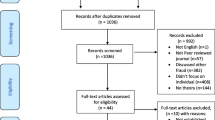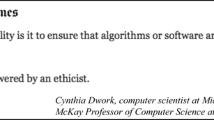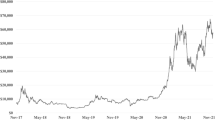Abstract
Economists at the Federal Trade Commission engage in economic analysis of a diverse set of behaviors, practices, and policies in support of the agency’s consumer protection and competition missions as demonstrated by the four projects that are the focus of this article. Consumer protection economists provided economic analysis in the first two projects discussed, which both involve fraud. However, one of the projects was an enforcement action, and the other was a pure research project. The final two projects are antitrust matters: a proposed merger of software firms; and a case that was brought to stop anticompetitive exclusionary conduct.



Similar content being viewed by others
Notes
Sometimes this research is part of large Commission studies that involve both legal and economic analysis. Examples of this are an ongoing study of Patent Assertion Entities, http://www.ftc.gov/news-events/press-releases/2013/09/ftc-seeks-examine-patent-assertion-entities-their-impact and a recently announced study of remedies in FTC merger cases, https://www.ftc.gov/news-events/press-releases/2015/01/ftc-proposes-study-merger-remedies. BE staff also work on more focused economics research projects that are often published in academic economics journals and/or released in the BE Working Paper series (https://www.ftc.gov/policy/reports/policy-reports/economics-research/working-papers).
See, for instance, numerous advocacy comments at https://www.ftc.gov/policy/advocacy/advocacy-filings.
FTC & Department of Justice (2015).
FTC & Department of Justice (2015) at p. 5.
See https://www.ftc.gov/competition-enforcement-database for a table of these merger and non-merger enforcement statistics for each year starting in 1996.
Conference materials can be found at https://www.ftc.gov/news-events/events-calendar/2014/10/seventh-annual-federal-trade-commission-microeconomics.
See FTC v. T-Mobile, Inc., No. 2:14-cv-0097-JLR (W.D. Wash. Dec. 19, 2014) and FTC versus AT&T Mobility, LLC, No. 1:14-cv-3227-HLM (N.D. Ga. Oct. 8, 2014).
See FTC v. T-Mobile, Inc and FTC versus AT&T Mobility, LLC.
See FTC v. Wise Media, LLC., No. 1:13-cv-1234-WSD (N.D. Ga. Apr. 16, 2013).
See FTC v. Tatto, Inc., No. 2:13-cv-08912-DSF-FFM (C.D. Cal. Dec. 5, 2013).
In the language of Hirschman (1970), requesting refunds corresponds to consumer “voice”, and switching amounts to consumer “exit”.
See California Public Utilities Commission (2013).
See NACHA (2013). These chargeback rates do not include refunds for product returns.
See Gaynor (2006) for an analysis of competition and quality.
This assumption rules out autocorrelation in refund rates conditional on type. There was some autocorrelation in refund rates, but inspection of the autocorrelation matrix and auto-regressive regressions revealed that the degree of autocorrelation was fairly low and was limited to the first lag.
See CFPB v. Sprint Corp., 14 CV 9331 (S.D. NY Dec. 1, 2014) and CFPB v. Verizon Wireless, 15 CV 3268 (D. NJ May 12, 2015).
See FTC (2014b).
For a detailed description of these characteristics and a discussion of how they were measured for this study, see McAlvanah et al. (2015).
See In the Matter of Verisk Analytics, Inc., Docket No. 9363 (Dec. 16, 2014) (henceforth Complaint) at ¶ 3 available at https://www.ftc.gov/system/files/documents/cases/141216veriskcmpt.pdf.
Contractors who prepare bids for projects that are unrelated to insurance claims are the other large class of customers using these products.
See EagleView; About Us. http://www.eagleview.com/AboutUs.aspx.
See Complaint at ¶ 40.
Xactimate was based on a very large database that contained detailed and constantly updated cost information on all construction-related costs in very localized areas across the entire country. Xactimate provided estimates for other building repairs as well, but these services were not implicated in the merger.
See Eagle View Technologies, Inc., Plaintiff, v. Xactware Solutions, Inc., Defendant. Complaint for Declaratory and Injunctive Relief, Exhibit A at ¶ 3.
See Complaint at ¶ 40. The only other usable image library for this purpose had less coverage, and typically had lower resolution than Pictometry’s library, which made estimates less accurate. Verisk documents indicated that Verisk had plans to complete its library. See Complaint at ¶ 40. Indeed when the merger was abandoned, Verisk announced it would continue to capture images. THOMSON REUTERS STREETEVENTS EDITED TRANSCRIPT VRSK–Q4 2014 Verisk Analytics Earnings Call Event Date/Time: February 25, 2015/1:30PM at ¶ 9.
See Complaint at ¶ 3.
See Complaint at ¶ 18.
See Complaint at ¶ 3.
See Complaint at ¶ 29.
See Complaint at ¶ 20.
See Complaint at ¶ 21.
See Complaint at ¶ 38 and 39.
For example, Verisk suspended ongoing negotiations with a number of prospective customers until the merger outcome was resolved. (Complaint at ¶ 36).
See Complaint at ¶ 39. Note that if these customers could not be served for a particular property by Roof InSight, they could go back to EagleView for a dimension estimate.
See Complaint at ¶ 39.
See Complaint at ¶ 44.
See Complaint at ¶ 35.
See US Department of Justice and FTC (2010), henceforth Guidelines, at p. 8.
See Complaint at ¶ 26.
See Guidelines at 10. A SSNIP test asks whether a hypothetical monopolist controlling all products in the proposed relevant market would find it profitable to impose a “small but significant non-transitory increase in prices”, or SSNIP. If so, the Guidelines suggest that the set of products constitutes a relevant antitrust product market for the purposes of merger analysis.
See Complaint at ¶ 1.
This estimated lower price could be based on the lower prices that were received by the two carriers that switched to Roof InSight. In most mergers where the theory of harm is that prices will increase from their pre-merger levels and would remain at their pre-merger levels but for the merger, the appropriate benchmark is the pre-merger price. In this case, because the theory is that price would decrease but for the merger, the appropriate benchmark is that lower price.
To formalize this intuition, the Commission could show that the appropriate benchmark price would be at least 5 % below the pre-entry price. Then there would be one SSNIP of greater than 5 % that was profitable. To show that a 5 % increase would be profitable (as is customary in the Guidelines), one could appeal to a mild assumption of monotonicity of profit with respect to price over this price range.
Even if Verisk were going to abandon its image library, there would be little benefit in this market from combining the production complements. Primarily this is because the number of claims that are processed effectively is exogenously determined by the number of roofs damaged by weather and fire, and therefore independent of the price of processing claims. For each claim, a carrier must decide whether to use RAMP or measure manually, and decide whether to use Xactimate or some other cost-estimation process. Carriers make these decisions independently of each other.
As a result, merging the ownership of the monopoly RAMP and the dominant cost estimation software creates no incentive for the new owner to lower the individual price of either input. For example, if the owner were to lower the price of cost estimation software, some customers might switch from, say, in-house cost calculation to cost estimation software. However, this would not cause any of them to switch to RAMP. And since the number of claims is determined by exogenously determined roof damage, no additional claims would be filed to create new opportunities for customers to buy additional RAMP. Thus, the merger creates no additional incentive to lower the price of cost-estimation software. Similar analysis implies that there would be no incentive to lower the price of RAMP individually.
Such a merger could create an incentive for the merged firm to use mixed bundling to sell RAMP and cost-estimation software. However, there is no reason to believe mixed bundling would make customers better off than individual goods pricing, and it is easy to write down examples in which consumers as a whole are worse off under mixed bundling than under individual goods pricing.
An archive of the FTC’s comments on these and other proposed state laws and regulations is available at https://www.ftc.gov/policy/advocacy/advocacy-filings.
See Administrative Complaint, In re North Carolina Board of Dental Examiners, No. 9343 (June 17, 2010) at p. 1, available at https://www.ftc.gov/sites/default/files/documents/cases/2010/06/100617dentalexamcmpt.pdf.
See Opinion of the Fourth Circuit Court of Appeals Denying Petitioner’s Petition for Review (May 31, 2013) at p. 5, available at https://www.ftc.gov/system/files/documents/cases/130531ncbdopinion.pdf.
See Administrative Complaint (June 17, 2010) at p. 4, available at https://www.ftc.gov/sites/default/files/documents/cases/2010/06/100617dentalexamcmpt.pdf.
See Complaint Counsel’s Pretrial Brief (January 19, 2011) at p. 7, available at https://www.ftc.gov/sites/default/files/documents/cases/2011/01/110119ncbriefcmpt.pdf.
See Syllabus, North Carolina State Board of Dental Examiners v. Federal Trade Commission, No. 13-534 (Feb. 25, 2015), available at https://www.ftc.gov/system/files/documents/cases/150225ncdentalopinion.pdf.
Dr. John Kwoka testified at trial as an economic expert on behalf of the FTC, and Dr. David Baumer testified as an economic expert on behalf of the Board.
See Initial Decision, In re North Carolina Board of Dental Examiners, No. 9343, at p. 8, available at https://www.ftc.gov/sites/default/files/documents/cases/2011/07/110719ncb-decision.pdf.
See Opinion of the Commission, In re North Carolina Board of Dental Examiners, No. 9343, available at https://www.ftc.gov/sites/default/files/documents/cases/2011/12/111207ncdentalopinion.pdf.
Many dentists own their own practices, and relatively few are directly employed by firms. So, in many instances the dental firm and the dentist are one and the same. But it is conceptually possible to distinguish between these two functions, and doing so will prove useful below.
As mentioned above, consumers also have the option of purchasing do-it-yourself teeth whitening kits. Since these kits were not the target of exclusionary conduct, and were available both pre- and post-exclusion, we treat consumers who purchase these kits as “not purchasing teeth whitening services.” However, the presence of these kits as an alternative likely mitigated the effects of the exclusion.
Figure 2 depicts total consumer surplus under the assumption that θ i is uniformly distributed, but this is not central to the analysis.
This is for simplicity; the effects of only partially effective exclusion are qualitatively similar.
It is straightforward to show that \(\theta_{D}^{1} > \theta_{ND}^{0}\). Recall that \(\theta_{ND}^{0}\) represents the θ i of a consumer who, pre-exclusion, is indifferent between non-dental whitening and not buying at all, and who strictly prefers both of those choices to dental whitening. Nothing changes for this consumer when non-dental whitening is excluded, and the removal of an irrelevant alternative cannot affect the ranking of the remaining choices, so not buying must still be strictly preferred to dental whitening post-exclusion. The consumer who, post-exclusion, is indifferent between dental whitening and not buying must have a higher θ i than this. A similar argument can be used to show that \(\theta_{D}^{1} < \theta_{D}^{0}\).
See FTC (2014a).
See FTC (2014a).
Some clearly do not. For example, the fact that doctors and lower-level providers can be easily distinguished eliminates the asymmetric information problem. See also Tabarrok & Cowen (2015) for an argument that asymmetric information generally is decreasing throughout the economy.
See Council of Economic Advisers (2015), Kleiner (2015), and Svorny (2000). However, this result is not universal. For example, Stange (2014) finds that expansion of the supply of nurse practitioners and physician assistants does not always increase primary care utilization, but rather only does so in those areas that grant them the greatest autonomy to practice independently.
If it were to turn out that licensing restrictions did systematically increase quality, then the literature on price effects would be needed for any attempt to balance the benefits against the harm. But as shown below, this is not the case.
Dr. Martin Giniger testified at trial as an expert in dental quality on behalf of the FTC, and Dr. Van Haywood testified as an expert in dental quality on behalf of the Board.
See Opinion of the Commission (Dec. 7, 2011) at pp. 26 and 28, available at https://www.ftc.gov/sites/default/files/documents/cases/2011/12/111207ncdentalopinion.pdf.
References
Adams, C. (2015). Finite mixture models with one exclusion restriction. Retrieved October 19, 2015, from the Social Science Research Network’s Web site. http://ssrn.com/abstract=2572583
Allman, E. S., Matias, C., & Rhodes, J. A. (2009). Identifiability of parameters in latent structure models with many observed variables. The Annals of Statistics, 37(6a), 3099–3132.
Anderson, K. B. (2013). Consumer fraud in the United States: The third FTC survey. Staff Report of the Bureau of Economics. Retrieved October 19, 2015, from FTC Web site. https://www.ftc.gov/sites/default/files/documents/reports/consumer-fraud-united-states-2011-third-ftc-survey/130419fraudsurvey_0.pdf
Balan, D. J., & Deltas, G. (2013). Better product at same cost, lower sales and lower welfare. International Journal of Industrial Organization, 31(4), 322–330.
Balan, D. J., & Deltas, G. (2014). Better product at same cost: Leader innovation vs generic product improvement. In M. Peitz & Y. Spiegel (Eds.), The analysis of competition policy and sectoral regulation (pp. 93–113). Singapore: World Scientific Publishing.
Benaglia, T., Chauveau, D., & Hunter, D. R. (2009a). An EM-like algorithm for semi-and nonparametric estimation in multivariate mixtures. Journal of Computational and Graphical Statistics, 18(2), 505–526.
Benaglia, T., Chauveau, D., Hunter, D., & Young, D. (2009b). Mixtools: An r package for analyzing finite mixture models. Journal of Statistical Software, 32(6), 1–29.
Bonhomme, S., Jochmans, K., & Robin, J. M. (2014). Nonparametric estimation of finite mixtures (No. CWP11/14). Retrieved October 19, 2015, from the Centre for Microdata Methods and Practice Web site. http://www.cemmap.ac.uk/wps/cwp111414.pdf
California Public Utilities Commission. (2013). Letter to Melanie K. Tiano, Senate Committee on Commerce, Science, and Transportation, Re: Inquiry Regarding Wireless California Cramming Complaint Data. Retrieved October 19, 2015, from FCC Web site: http://apps.fcc.gov/ecfs/document/view?id=7022119377
Council of Economic Advisers. (2015). Occupational licensing: A framework for policymakers. Retrieved October 19, 2015, from White House Web site. https://www.whitehouse.gov/sites/default/files/docs/licensing_report_final_nonembargo.pdf
Federal Trade Commission. (2014a). Competition and the regulation of advanced practice nurses. Retrieved October 19, 2015, from Federal Trade Commission Web site. https://www.ftc.gov/system/files/documents/reports/policy-perspectives-competition-regulation-advanced-practice-nurses/140307aprnpolicypaper.pdf
Federal Trade Commission. (2014b). Mobile cramming: An FTC staff report. Retrieved October 19, 2015, from FTC Web site. https://www.ftc.gov/system/files/documents/reports/mobile-cramming-federal-trade-commission-staff-report-july-2014/140728mobilecramming.pdf
Federal Trade Commission & Department of Justice. (2015). Hart–Scott–Rodino Annual Report, Fiscal Year 2014. Retrieved October 19, 2015, from FTC Web site. https://www.ftc.gov/system/files/documents/reports/federal-trade-commission-bureau-competition-department-justice-antitrust-division-hart-scott-rodino.s.c.18a-hart-scott-rodino-antitrust-improvements-act-1976/150813hsr_report.pdf
Gaynor, M. (2006). What do we know about competition and quality in health care markets? Foundations and Trends in Microeconomics, 2, 6.
Hall, P., Neeman, A., Pakyari, R., & Elmore, R. (2005). Nonparametric inference in multivariate mixtures. Biometrika, 92(3), 667–678.
Hall, P., & Zhou, X. H. (2003). Nonparametric estimation of component distributions in a multivariate mixture. Annals of Statistics, 31, 201–224.
Hirschman, A. O. (1970). Exit, voice, and loyalty: Responses to decline in firms, organizations, and states. Cambridge: Harvard University Press.
Kasahara, H., & Shimotsu, K. (2014). Non-parametric identification and estimation of the number of components in multivariate mixtures. Journal of the Royal Statistical Society: Series B (Statistical Methodology), 76(1), 97–111.
Kleiner, M. M. (2015). Reforming occupational licensing policies. Hamilton Project Discussion Paper, 2015-01.
Kleiner, M. M., & Kudrle, R. T. (2000). Does regulation affect economic outcomes? The case of dentistry. Journal of Law and Economics, 43(2), 547–582.
Kleiner, M. M., Marier, A., Park, K. W., & Wing, C. (2014). Relaxing occupational licensing requirements: Analyzing wages and prices for a medical service (No. w19906). National Bureau of Economic Research.
Leland, H. E. (1979). Quacks, lemons, and licensing: A theory of minimum quality standards. Journal of Political Economy, 87(6), 1325–1346.
Levine, M., Hunter, D. R., & Chauveau, D. (2011). Maximum smoothed likelihood for multivariate mixtures. Biometrika, 98(2), 403–416.
McAlvanah, P., Anderson, K., Letzler, R., & Mountjoy, J. (2015). Fraudulent advertising susceptibility: An experimental approach. Federal Trade Commission Bureau of Economics Working Paper #325. Retrieved October 19, 2015, from FTC Web site. https://www.ftc.gov/system/files/documents/reports/fraudulent-advertising-susceptibility-experimental-approach/wp325.pdf
NACHA: The Electronic Payments Association. (2013). ACH network risk and enforcement topics, request for comment and request for information, executive summary and rules description. Retrieved October 19, 2015, from http://www.ballardspahr.com/~/media/files/alerts/2013-11-25-nacha.pdf
Ohlhausen, M. K., & Luib, G. P. (2015). Brother, may I? The challenge of competitor control over market entry. Journal of Antitrust Enforcement. Retrieved October 19, 2015, from http://antitrust.oxfordjournals.org/content/early/2015/09/10/jaenfo.jnv028.abstract
Shapiro, C. (1986). Investment, moral hazard, and occupational licensing. The Review of Economic Studies, 53(5), 843–862.
Sims, C. A. (2003). Implications of rational inattention. Journal of Monetary Economics, 50(3), 665–690.
Stange, K. (2014). How does provider supply and regulation influence health care markets? Evidence from nurse practitioners and physician assistants. Journal of Health Economics, 33, 1–27.
Svorny, S. (2000). Licensing, market entry regulation. In B. Bouckaert & G. De Geest (Eds.), Encyclopedia of law & economics. The regulation of contracts (pp. 296–328). Cheltenham, UK: Edward Elgar.
Tabarrok, A., & Cowen, T. (2015). The end of asymmetric information. Cato Unbound. Retrieved October 19, 2015, from http://www.cato-unbound.org/2015/04/06/alex-tabarrok-tyler-cowen/end-asymmetric-information
U.S. Department of Justice & the Federal Trade Commission. (2010). Horizontal Merger guidelines. Retrieved October 19, 2015, from FTC Web site. http://www.ftc.gov/os/2010/08/100819hmg.pdf
Wanchek, T. (2010). Dental hygiene regulation and access to oral healthcare: Assessing the variation across the US states. British Journal of Industrial Relations, 48(4), 706–725.
Acknowledgments
We thank James Lacko, Janis Pappalardo, Andrew Stivers, and Michael Vita for helpful comments and Marissa Wheeler for considerable research assistance. The views that are expressed in this article are those of the authors and do not necessarily reflect those of the Federal Trade Commission or any of the individual Commissioners.
Author information
Authors and Affiliations
Corresponding author
Rights and permissions
About this article
Cite this article
Balan, D.J., DeGraba, P., Lafontaine, F. et al. Economics at the FTC: Fraud, Mergers and Exclusion. Rev Ind Organ 47, 371–398 (2015). https://doi.org/10.1007/s11151-015-9488-6
Published:
Issue Date:
DOI: https://doi.org/10.1007/s11151-015-9488-6




